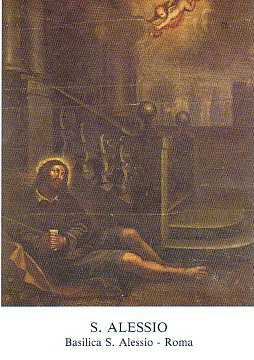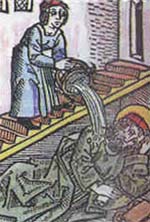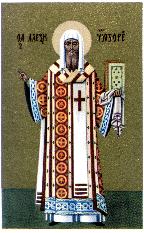

축일:7월 17일
성 알렉시오 은수자
Sant’ Alessio Mendicante
St. Alexius, C
Alexis; The Man of God
Died:c.early 5th century
sec. V (AD 350?)
Name Meaning: defender; helper

알렉시오는 "나는 보호한다"란 뜻이다.
그를 "하느님의 사람"으로만 언급한 작자 미상인 한 전기에서,
그는 어느 부유한 로마 원로원의 아들이었고, 어렸을 때부터 그의 애덕이 널리 알려져 있었다는 사실과
어느 부유한 로마 여인과 결혼하여 부모를 기쁘게 했다는 정도로만 알려져 있었다.
그런데, 그들은 결혼식 날에 서로 동의하여 갈라섰으며, 그는 시리아로 가서 17년을 살았다.
알렉시오는 에데싸의 어느 성당에 기거하면서 놀라운 청빈덕을 실천하면서 성덕을 닦았다고 한다.
자신이 기거하는 성당의 마리아상이 자신을 "하느님의 사람" 이라고 에데싸의 주민들에게 알렸을 때,
그는 로마로 돌아 왔다. 그러나 그의 부친이 구걸하는 자식을 알아 보지 못하였다고 한다.
그의 부친은 자기 자식인 줄 모르고 그에게 일거리를 주고 자기 집 계단 및에 기거하게 했다.
만인들로부터 잊혀진 인물로서 그는 로마에서 17년을 살았다.
그의 신원이 밝혀진 때는 그가 죽고 난 뒤 그의 자서전이 발견되면서부터 였다.
이 이야기는 서방으로 급속도로 퍼져나갔다.
학자들은 알렉시오가 확실히 생존했으며, 에데싸에 묻혔다고 믿었다.
(성바오로수도회홈에서)


15세기의 일이다.
병자 특히 정신병자 및 버림을 받은 사망자들의 매장을 목적으로 하는 한 자선 수도회가 창립되어,
회칙은 아우구스티노회의 회칙을, 주보 성인은 성 알렉시오로 해서 알렉시오 수도회라 칭했다.
알렉시오 성인은 본래 초대 교회의 성인으로서, 오랫동안 알려지지 않았으나
10세기 로마의 아벤티노 언덕에 그에게 봉헌된 성전이 건축된 후로부터 그를 공경하는 열이 높아진 것이다.
그의 생애에 대한 확실한 기록은 별로 없고, 오직 전설 정도로 전해오는 이야기가 있으며,
우선 그 전설에 대한 역사적 가치 여하는 접어 놓고라도
중세기에 이르러 순박하고 독실한 신자들의 입과 입을 거쳐 내려오는 이야기 중에는
참으로 아름답고 감회 깊은 것이 많다.
그에 의하면 성 알렉시오는 4세기 말경 로마의 한 귀족 에우페미아노의 아들로 태어났다.
부모가 다 착실하며 자애심이 두텁고, 신분은 귀하지만 덕행을 중히 여기고
물질을 가볍게 알아 빈민을 구호함을 보람있게 여겼으므로,
어린 알렉시오는 그들의 감화를 받아 일찍이 세상 쾌락의 헛됨을 깨닫고 덕의 길로 매진했다.
나이가 들어서, 양친은 적당한 배우자를 선택해 결혼을 권유했다.
그리하여 결혼식을 올렸는데, 그 날 밤 돌연 하느님을 위해서만 일생을 바치겠다는 열망이 일어난 알렉시오는
즉시 집을 나와 막 출항하려는 배를 타고 멀리 소아시아 지방에 있는 에데사 시로 도피했다.
그곳에서 성모 마리아 성당의 일을 보살폈다. 덕이라는 것은 오래 숨길수 없는 법이다.
그러는 동안에 그의 덕행은 드러나게되어 사람들의 이야기 거리가 되었다.
겸손한 알렉시오는 이것이 매우 근심이 되어 에데사 시를 떠나 다른 지방으로 가려고 했다.
그러나 하느님의 섭리는 알 수 없었다.
그가 탄 배는 풍랑과 싸우며 마침내 한 곳에 착륙했는데 그곳이 공료롭게도 그의 출생지인 로마였다.

알렉시오는 보잘것 없는 순례자 모양으로 시내를 방황하며 여전히 거지생활을 하는 중
어느 날 그리운 그의 아버지를 만나게 되엇다.
이별한 지 오래 되었다는 것보다 거지생활로 초라해진 그의 모습을 아버지인들 알아볼 길이 없었다.
그래서 알렉시오는 그 곁에 가서 공손히 인사를 하고 헛간이라도 좋으니
한 구석만 빌려 주신다면 비바람을 면할 수 있겠다고 간청했다.
이 청을 듣자 역시 자애심이 깊은 옛날 그대로의 아버지인지라,
쾌히 승낙하고 계단 밑에 있는 한쪽 구석을 빌려 주었다.
이리하여 그는 반생을 자기 집이라고 할 수도 없는 자기 집에서 경건히 지내게 되었다.
그동안 하인들에게 게으른 자, 귀찮은 자라는 등등의 모욕도 많이 받았다.
그럴 때마다 그는 온화한 마음으로 참으며 한 마디도 대꾸를 하지 않았다.
그리고 그의 양친, 또 그와 베게를 같이 해보지 못한 그의 처가 그의 행방을 몰라서 탄식할 때마다
그는 온갖 말로 그들을 위로해 주기도 했다.

알렉시오는 검소한 생활, 끊임없는 단식재와 고행, 기도와 묵상 등을 하며
하루하루를 성스럽게 지낸 그의 건강은 과도한 고신 극기로 인해 쇠약해져서,
그는 마침내 노부모를 뒤로하고 아무도 모르는 사이에 세상을 하직하고야 말았다.
집안에서 그의 주검을 발견했을 때에 그의 얼굴에는 천상 평화의 빛이 비쳐 있었고,
그의 손에는 종이 한 장이 쥐어져 있었다.
그 종이에는 자신의 본래의 신분이며, 자신이 집을 나간 이유,
그리고 자신으로 말미암아 부모와 정숙한 자신의 아내가 오랫동안 슬픔의 생활을 하게 한 것을 깊이 사과하고,
그 대신 자신이 천국에서 많은 기도로써 갚아 주겠다는 기록이 있었다.
비로소 이 사실을 알게 된 부모와 그의 처는 너무나 놀랐고, 그의 온 집안은 새로운 눈물로 지새웠던 것이다.
(대구대교구홈에서)



♬Hear my prayer-O for the wings of Dove- Mendelssohn-Anthony Way
Sant' Alessio Mendicante
17 luglio
Roma o Costantinopoli (?) V secolo – Roma, 17 luglio anno ?
Fattosi povero, da patrizio qual era, Alessio trascorreva le notti sotto una scala sul colle romano dell’Aventino. In quel luogo Papa Onorio III gli dedicò nel 1217 una chiesa, scelta ancora oggi per molti matrimoni che si celebrano nell’Urbe. Ma quella della scala è soltanto una delle due tradizioni esistenti sul santo. Secondo quella siriaca, infatti, il giovane fuggì la sera delle nozze per recarsi a Edessa, dove visse da mendicante e morì. La variante greco-romana introduce il ritorno a Roma (raffigurato nelle pitture della chiesa inferiore della basilica San Clemente). Qui Alessio visse sempre da mendico e non venne riconosciuto dal padre. Fu Papa Innocenzo a scoprirne l’identità e a comunicarla ai genitori, che, straziati, si recarono al capezzale del figlio ormai morente. Una scena spesso raffigurata nell’arte. Della figura di Alessio si è impadronita anche la letteratura. (Avvenire)
Patronato:Mendicanti
Etimologia: Alessio = protettore, difensore, dal greco
Tutto sommato la vita di s. Alessio si può descrivere con poche frasi, ma sono le varie narrazioni del tempo antico, che ne arricchiscono lo svolgimento in buona parte leggendario.
Vi sono tre versioni della ‘Vita’: la leggenda siriaca, la leggenda greca, la leggenda latina, che hanno trasformato la semplice e umile vita di un uomo di Dio, mendicante e asceta del V secolo, in un fiorito racconto che è stato oggetto di opere teatrali e di poesia, sia in Oriente che in Occidente.
La leggenda siriaca, la prima composta fra il 450 e il 475, il cui manoscritto più antico risale alla fine del V secolo, narra di un giovane e ricco abitante della nuova Roma cioè Costantinopoli, il quale la sera delle nozze si era allontanato di nascosto imbarcandosi per l’Oriente.
Giunto ad Edessa, città dell’odierna Siria, che nel IV-V secolo era un centro di cultura cristiana (Scuola di Edessa), finché nel VII secolo passò ai musulmani, qui si mise a chiedere l’elemosina con altri mendicanti sull’uscio della chiesa.
Quello che raccoglieva di giorno, lo distribuiva di sera ai poveri della città, per il suo ascetismo venne chiamato Mar-Riscia (uomo di Dio); persone incaricate dal padre di ritrovarlo, giunti anche ad Edessa, non riuscirono ad identificarlo in quel mendicante lacero ed emaciato.
Dopo 17 anni, quando si sentì morire, il giovane mendicante rivelò al sacrestano della chiesa la sua vera identità ed origine, il quale una mattina lo trovò morto sul sagrato.
Il sacrestano si precipitò dal vescovo Rabula (412-435) e lo supplicò di non far confondere nella fossa comune, il corpo di quel santo uomo, il vescovo allora si recò al cimitero per esumarlo, ma trovò solo le misere vesti, il corpo era scomparso.
Nel secolo IX comparve documentata la leggenda greca o bizantina, la quale trasformava significativamente quella siriaca. Prima di tutto dava un nome al giovane chiamandolo Aléxios (Alessio) che significa “difensore” o “protettore”, situando la sua nascita a Roma e non più in Oriente e datando la sua morte al 17 luglio, al tempo degli imperatori fratelli Arcadio e Onorio (395-408).
La leggenda narra che un’icona della Vergine Maria nella chiesa di Edessa (oggi secondo la tradizione, venerata nella chiesa romana di Sant’Alessio sull’Aventino), ordinò al sacrestano di far entrare in chiesa quel mendicante da considerarsi un santo, la voce si diffuse rapidamente fra il popolo dei fedeli, che presero a venerarlo.
Alessio cui non piacevano gli onori, fuggì imbarcandosi per Tarso, ma i venti prodigiosamente lo fecero approdare sulle coste italiane ad Ostia; questo fatto fu preso da Alessio come un’indicazione divina, pertanto decise di farsi ospitare come uno straniero povero nella casa paterna a Roma.
Il padre memore del figlio lontano e in difficoltà, senza riconoscerlo lo accolse con benevolenza in casa, dove Alessio rimase per 17 anni, dormendo in un sottoscala fra le umiliazioni e gli scherni dei servi.
Quando Alessio sentì che la sua fine era vicina, decise di scrivere le avventure e le origini della sua vita su un rotolo, quando morì le campane di Roma si misero a suonare a festa e fu udita una voce divina che diceva: “Cercate l’uomo di Dio affinché egli preghi per Roma”, così fu scoperto il corpo del santo, ancora con il rotolo in mano, che solo gli imperatori Arcadio ed Onorio riuscirono a sfilarglielo e leggere.
Della leggenda latina non si hanno documentazioni prima del secolo X, comparve prima in Spagna e verso l’ultimo quarto del secolo a Roma.
Qui il culto fu diffuso dall’arcivescovo metropolita di Damasco Sergio, il quale costretto a fuggire a seguito dell’invasione dei Saraceni, si stabilì presso la chiesa di San Bonifacio sull’Aventino, qui fondò una comunità monastica mista, dove i greci osservavano la Regola di s. Basilio e i latini quella di s. Benedetto.
Questa comunità rivestì una grande importanza in quel tempo e fra l’altro rielaborò la leggenda greca di s. Alessio in una versione che diventò la tradizione dominante in Occidente, tale da essere inserita nella “Leggenda Aurea” di Jacopo da Varagine.
Le diversità apportate nella leggenda latina sono: la chiesa dove Alessio si sarebbe dovuto sposare divenne la stessa basilica dove il santo sarebbe stato sepolto; la mancata sposa, che la sera precedente le nozze accettò di vivere in castità, si chiamò chi sa perché Adriatica; il rotolo con scritta la sua vita, fu tolto di mano non dagli imperatori, ma dal papa stesso, presenti gli straziati genitori Eufemiano e Aglae, che finalmente seppero che quel mendicante in abiti da pellegrino, vissuto nella loro casa, era l’amato figlio.
Questa nuova versione latina ispirò canti popolari e leggende che i contadini si tramandavano da padre in figlio.
Nel 1217 papa Onorio III dedicò la chiesa di S. Bonifacio anche al leggendario s. Alessio; dell’antica chiesa, dopo i vari rifacimenti non è rimasto quasi nulla, nell’attuale basilica barocca, c’è la Cappella di S. Alessio e in essa è contenuto un frammento lungo circa un metro della scala sotto la quale il santo dormiva, il frammento sovrasta la statua in marmo, raffigurante s. Alessio sul letto di morte, vestito da pellegrino di Santiago, opera dello scultore Antonio Bergondi, seguace del Bernini.
Testimonianza artistica sulla sua vita è il ciclo di affreschi di fine XI secolo, situato nella chiesa inferiore di San Clemente a Roma; in questo ciclo compaiono già gli attributi che lo identificano, come la scala, il bastone da pellegrino, la lettera nella mano serrata dalla morte, che verranno poi ripresi dai tanti artisti che lo hanno raffigurato nei secoli successivi.
A conclusione è opportuno notare come il numero 17 compaia più volte nella vita di s. Alessio; 17 sono gli anni passati ad Edessa e 17 quelli trascorsi a Roma in casa de padre; il 17 luglio è la data ritenuta della sua morte, come pure egli viene celebrato in Oriente il 17 marzo e in Occidente il 17 luglio.
Ancora oggi nella Basilica di S. Alessio sull’Aventino, molte coppie di sposi vogliono qui celebrare il loro matrimonio.
Autore: Antonio Borrelli
Alexius
Also known as
Alexis; The Man of God
Memorial
17 July
Profile
Only son of a wealthy Christian Roman senator. Wanted to devote himself to God, but his parents arranged a marriage for him. On his wedding day his fiancee agreed to release him and let him follow his vocation. He fled his parent's home disguised as a beggar, and lived near a church in Syria. A vision of Our Lady at the church pointed him out as exceptionally holy, calling him the "Man of God". This drew attention to him, which caused him to return to Rome where he would not be known. He came as a beggar to his own home. His parents did not recognize him, but were kind to all the poor, and let him stay there. Alexis lived for seventeen years in a corner under the stairs, praying, and teaching catechism to small children. After his death, his family found a note on his body which told them who he was and how he had lived his life of penance from the day of his wedding until then, for the love of God.
Died
early 5th century
Name Meaning
defender; helper
Patronage
Alexians; beggars; belt makers; nurses; pilgrims; travellers
Representation
dying man with a letter in his hand; man holding a ladder; man in a pilgrim's habit holding a staff; man lying beneath a staircase; man lying on a mat
Alexis of Rome (RM)
(also known as Alexius, Alessio)
Early 5th century. Since the 10th century the story of Saint Alexis, called the "Man of God" by his unknown biographer, has been popular throughout the West. It was introduced from the East by some Greek monks who were given the Benedictine abbey of Saint Boniface on the Aventine, which was renamed Saint Boniface and Saint Alexis. In 1216, his bones were discovered by Pope Honorius III and reverently placed under the high altar of the church.
Though much of the legend is probably apocryphal, there is no doubt that there was a man of God called Alexis and that he achieved a great reputation for holiness at Edessa. It is, however, likely that he lived, died, and was buried at Edessa, and that the man whose bones were found in Saint Boniface's were not his. The legend appears to be a conflation of the life of Saint John Calybites and that of the Man of God Mar Riscia of Edessa.
According to an almost contemporary account, a nameless man died in a hospital at Edessa in Mesopotamia about 430. He had lived by begging, and shared the alms he received with other poor people. After his death, it was learned that he was the son of a Roman patrician, who had left a wealthy bride on his wedding day and gone to live in poverty in Syria. An account of this man, which called him Alexis, was written in Greek, and a further narrative was produced in Latin.
According to the expanded late medieval version, Alexis was the only son of Euphremian, a Roman senator of enormous wealth and influence, and his wife Aglae (Agloe). They were devout Christians and brought up their son in the spirit of the Gospel. Even as a child, Alexis was known for his charity.
When Alexis reached manhood he allowed himself to be betrothed to an heiress who was related to the imperial family, though he had already determined to give his life to God. Their wedding took place with great pomp and dignity. As soon as the ceremony was ended, Alexis took off the gold ring that had just been placed on his finger, gave it to his bride. They separated by mutual consent and he fled from his home disguised as a beggar.
He set sail for Syria and then made his way on foot to the church of Our Lady of Edessa, famous as a shrine for pilgrims, where he lived in a shack adjoining the church. The Syrian text of his legend says: "During the day he remained steadfastly in the church and in the martyrium, refusing alms from those who offered them, for he wished to do without food during the day and thus forced himself to fast until the evening.
"In the evening, he stood in the doorway of the church and held out his hand, receiving the alms of those who entered the church. But as soon as he had received what he needed, he closed his hand and would take no more. Nor did he ever cease to live among the poor. Such was his life every day. Of his earlier condition and status he said not a word, nor did he even wish to reveal his name."
After living this life for 17 years, his identity was revealed; some say that he was recognized by a sacristan, others that the Blessed Virgin Mary appeared to the people and said: "Seek the man of God." To avoid discovery, Alexis fled and took ship for Tarsus, but a tempestuous wind drove his ship to Italy.
He went to Rome and to his father's house, where he found that his parents were still living. He did not make himself known, nor did anyone recognize him, and when he asked for lodging he was given permission to sleep under the staircase of his own sumptuous home; and so he lived, begging his bread in the streets and working in the kitchen, where he was often insulted by the servants and sharing crumbs of what was rightly his.
Seventeen years later while Pope Innocent I was celebrating Mass before the emperor, he heard a voice saying: "Seek the man of God." Guided by the selfsame voice, he and the emperor went to the house of Euphremian, but when they arrived they found Alexis dead. His body was lying clothed in rags beneath the staircase, and in his hand he was holding a parchment that gave his name and history.
There is no mention of Saint Alexis in the ancient martyrologies or other liturgical records. Attempts to identify him with Alethius, a correspondent of Saint Paulinus of Nola, have failed. By the 12th century, his story had reached England, where his name is found in the Albani Psalter that probably belonged to Saint Christina of Markyate (Attwater, Benedictines, Bentley, Delaney, Encyclopedia, Farmer).
In art, Saint Alexis is portrayed as a beggar or pilgrim holding a staircase (his emblem). He may also be shown (1) asleep by the stairs, dirty water emptied on him; (2) as a pilgrim with a staff and scrip; or (3) as a pilgrim, kneeling before the pope, to whom he gives a letter (Roeder). Alexis is the patron of beggars and pilgrims (Roeder).





